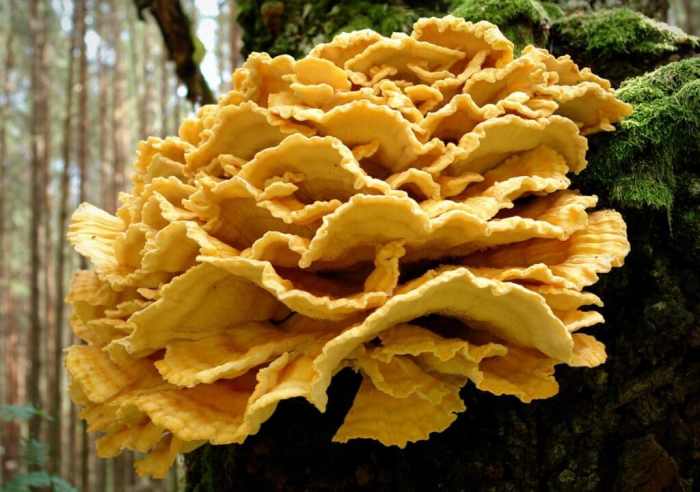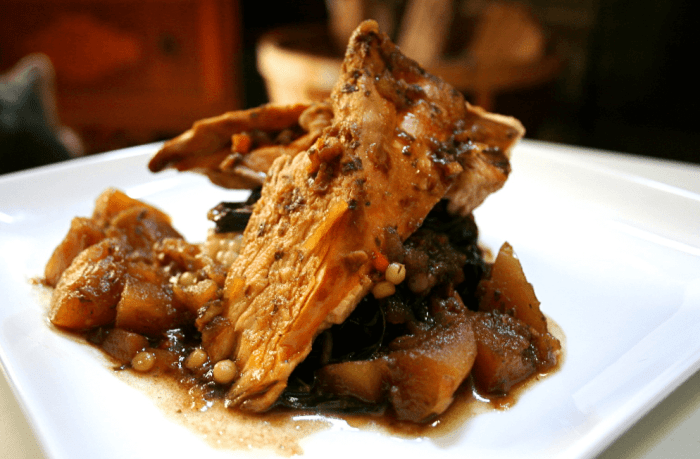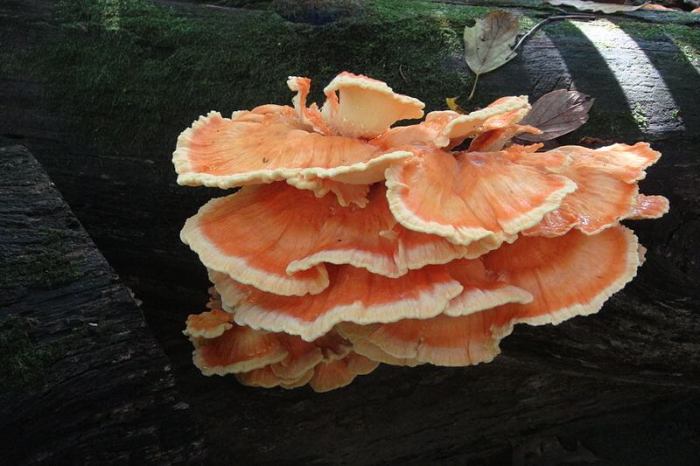
Chicken of the woods recipe, a culinary delight straight from the heart of nature, takes us on a gastronomic adventure like no other. With its vibrant colors and earthy flavors, this edible mushroom has captivated the hearts and taste buds of foragers and foodies alike.
Join us as we delve into the fascinating world of chicken of the woods, exploring its unique characteristics, harvesting techniques, and delectable culinary applications.
Whether you’re a seasoned mushroom enthusiast or a curious culinary explorer, this comprehensive guide will provide you with all the essential knowledge and inspiration you need to make the most of this forest delicacy. So, gather your baskets and prepare to embark on a culinary journey that will tantalize your taste buds and connect you with the wonders of nature.
Introduction to Chicken of the Woods

Chicken of the Woods, also known as Laetiporus sulphureus, is a polypore fungus renowned for its vibrant orange color and delectable taste resembling chicken meat. This fungus is found growing on the trunks and fallen logs of various hardwood trees, primarily oak, maple, and beech.
Chicken of the Woods is characterized by its shelf-like shape, which can range in size from a few inches to several feet. Its surface is covered in tiny pores, giving it a sponge-like texture. The flesh is firm, juicy, and white, with a mild, savory flavor that makes it a popular culinary choice.
Historical and Cultural Background
Chicken of the Woods has been consumed by humans for centuries. Archaeological evidence suggests that it was a food source for prehistoric cultures in Europe and North America. In traditional Chinese medicine, it is believed to possess medicinal properties and is used to treat various ailments.
In recent years, Chicken of the Woods has gained popularity among modern foragers and culinary enthusiasts due to its unique flavor and versatility in cooking. It can be sautéed, grilled, roasted, or fried, and can be incorporated into a wide range of dishes, from soups and stews to salads and pasta.
For a delightful culinary adventure, look no further than the chicken of the woods recipe . This edible fungus boasts a meaty texture and a slightly nutty flavor, making it a unique and satisfying alternative to traditional poultry. Its vibrant orange coloration adds a touch of flair to any dish, whether you’re preparing it as a savory stir-fry or a hearty soup.
Identification and Harvesting Techniques

Chicken of the Woods, with its vibrant colors and fleshy texture, is a delectable edible mushroom that can be found in various stages of growth. Identifying and harvesting it requires a keen eye and understanding of its characteristics. Here’s a comprehensive guide to help you confidently identify and gather this culinary gem.
Identifying Chicken of the Woods, Chicken of the woods recipe
- Young Mushrooms:In their early stages, Chicken of the Woods appears as small, yellow-orange bumps or clusters on the side of trees. These young mushrooms are often soft and have a delicate flavor.
- Mature Mushrooms:As they mature, Chicken of the Woods develops into large, shelf-like structures with a bright orange or yellow coloration. The edges of the shelves are typically wavy or lobed, and the underside is covered with tiny pores instead of gills.
- Older Mushrooms:In their final stages, Chicken of the Woods becomes tougher and more fibrous. The color may fade to a pale yellow or white, and the edges may become brittle and cracked.
Optimal Harvesting Methods
To ensure a successful harvest, it’s crucial to follow proper techniques:
- Choose Healthy Specimens:Select Chicken of the Woods mushrooms that are firm, brightly colored, and free of any signs of damage or decay.
- Harvest Young to Mature:Harvest Chicken of the Woods when they are young to mature, as they tend to be more tender and flavorful. Avoid harvesting older mushrooms that have become tough and fibrous.
- Use a Sharp Knife:Use a sharp knife to carefully cut the mushrooms from the tree. Avoid pulling or tearing them, as this can damage the mushroom and the tree.
- Leave Some Behind:When harvesting, always leave some mushrooms behind to ensure the continued growth and propagation of the species.
Storing and Preserving
Proper storage and preservation techniques are essential to maintain the freshness and quality of Chicken of the Woods:
- Refrigeration:Fresh Chicken of the Woods mushrooms can be stored in the refrigerator for up to a week. Wrap them loosely in paper towels or a damp cloth to maintain moisture.
- Drying:Drying is an excellent way to preserve Chicken of the Woods for extended periods. Slice the mushrooms thinly and dry them in a dehydrator or in the oven at low heat.
- Freezing:Freezing is another option for long-term storage. Blanch the mushrooms for a few minutes before freezing them in airtight containers.
Culinary Applications and Preparation

Chicken of the Woods is a versatile culinary delight, offering a range of flavors and textures that can elevate any dish. From sautéing to roasting, this mushroom’s adaptability makes it a favorite among chefs and home cooks alike.
To prepare Chicken of the Woods, start by cleaning the mushrooms thoroughly. Remove any dirt or debris with a damp cloth or brush. Cut the mushrooms into bite-sized pieces and discard any tough or woody parts.
Cooking Methods
The cooking method you choose will significantly impact the flavor and texture of Chicken of the Woods. Here are some popular options:
- Sautéing:Sautéing Chicken of the Woods in butter or oil brings out its savory flavor and tender texture. Cook over medium heat until golden brown and slightly crispy.
- Roasting:Roasting Chicken of the Woods in the oven intensifies its umami taste and creates a slightly chewy texture. Toss the mushrooms with olive oil and seasonings, then roast at 400°F (200°C) for 20-25 minutes.
- Grilling:Grilling Chicken of the Woods over high heat results in a smoky, charred flavor and a firm texture. Grill for 5-7 minutes per side until cooked through.
- Frying:Frying Chicken of the Woods in a tempura batter creates a crispy exterior and a tender interior. Dip the mushrooms in batter and fry at 350°F (175°C) until golden brown.
Nutritional Value and Health Benefits

Chicken of the Woods offers an impressive nutritional profile, making it a valuable addition to a healthy diet. It is low in calories and fat, while being a good source of dietary fiber, protein, vitamins, and minerals.
Nutritional Composition
- Calories:100 grams (3.5 ounces) of raw Chicken of the Woods contains approximately 30 calories.
- Fat:It is very low in fat, with only 0.5 grams per 100 grams.
- Fiber:Chicken of the Woods is a good source of dietary fiber, providing around 2.5 grams per 100 grams.
- Protein:It contains a moderate amount of protein, with approximately 3 grams per 100 grams.
- Vitamins:Chicken of the Woods is a good source of vitamin C, niacin, and riboflavin.
- Minerals:It is rich in minerals such as potassium, phosphorus, and iron.
Health Benefits
In addition to its nutritional value, Chicken of the Woods has several potential health benefits:
- Immune Support:Chicken of the Woods contains compounds that may help boost the immune system and protect against infections.
- Antioxidant Properties:It is a good source of antioxidants, which can help protect cells from damage caused by free radicals.
- Anti-inflammatory Properties:Some studies suggest that Chicken of the Woods may have anti-inflammatory properties.
Contraindications and Safety Considerations
While Chicken of the Woods is generally considered safe to eat, there are a few potential contraindications and safety considerations to be aware of:
- Allergic Reactions:Some people may be allergic to Chicken of the Woods. If you experience any allergic symptoms after consuming it, discontinue use and seek medical attention.
- Digestive Issues:Eating large amounts of Chicken of the Woods may cause digestive issues in some individuals.
- Interaction with Medications:Chicken of the Woods may interact with certain medications, such as blood thinners. Consult with a healthcare professional before consuming it if you are taking any medications.
Variations and Adaptations
Chicken of the Woods is a versatile mushroom that lends itself to a wide range of culinary creations. Its meaty texture and delicate flavor make it a suitable substitute for chicken in various dishes, inspiring chefs and home cooks alike to experiment with innovative recipes.
The adaptability of Chicken of the Woods extends beyond its culinary applications, as it can be incorporated into various cuisines and cultural traditions. Its unique flavor profile complements a diverse array of ingredients and flavors, allowing for endless possibilities in the kitchen.
If you’re looking for a more comprehensive guide, check out the chicken of the woods recipe provided by the Allen Community College. This detailed recipe provides step-by-step instructions on how to prepare and cook this delicious mushroom, ensuring a successful culinary experience.
Creative Recipes and Variations
- Chicken of the Woods “Fried Chicken”:Breaded and fried Chicken of the Woods mimics the crispy texture and savory taste of traditional fried chicken, offering a plant-based alternative with a delightful crunch.
- Chicken of the Woods Tacos:Shredded or sliced Chicken of the Woods forms a flavorful filling for tacos, accompanied by your favorite toppings such as salsa, guacamole, and cheese.
- Chicken of the Woods Risotto:Sautéed Chicken of the Woods adds an earthy depth to creamy risotto, creating a comforting and satisfying dish.
- Chicken of the Woods Soup:Simmered in a flavorful broth, Chicken of the Woods contributes its meaty texture and umami to hearty soups.
- Chicken of the Woods Stir-Fry:Sliced Chicken of the Woods stir-fried with vegetables and a flavorful sauce creates a quick and healthy meal.
Cuisines and Cultural Influences
- Asian Cuisine:In Asian cooking, Chicken of the Woods is often used in stir-fries, soups, and stews, where its meaty texture and umami flavor enhance the dishes.
- European Cuisine:In European countries, Chicken of the Woods is commonly sautéed or roasted with herbs and spices, highlighting its earthy flavor and versatility.
- North American Cuisine:In North America, Chicken of the Woods is often breaded and fried, mimicking the texture and taste of chicken, making it a popular meat substitute in various dishes.
Pairings with Other Ingredients and Flavors
Chicken of the Woods pairs well with a wide range of ingredients and flavors, allowing for endless culinary creations. Some popular pairings include:
- Herbs and Spices:Thyme, rosemary, oregano, and garlic complement the earthy flavor of Chicken of the Woods, enhancing its savory notes.
- Cheese:Creamy cheeses such as brie, goat cheese, and cheddar pair well with the meaty texture of Chicken of the Woods, creating a rich and satisfying combination.
- Vegetables:Sautéed or roasted vegetables, such as onions, peppers, and mushrooms, add a vibrant and colorful dimension to dishes featuring Chicken of the Woods.
- Sauces:Rich and flavorful sauces, such as creamy Alfredo, tangy barbecue, or spicy Szechuan, enhance the taste of Chicken of the Woods, creating a variety of culinary experiences.
Last Recap: Chicken Of The Woods Recipe

As we conclude our exploration of chicken of the woods recipe, we can’t help but marvel at the versatility and culinary potential of this extraordinary mushroom. From its vibrant colors to its earthy flavors, chicken of the woods has captured the hearts of gourmands and nature lovers alike.
Whether you choose to sauté, roast, or fry it, this forest delicacy is sure to elevate any dish to new heights of flavor and sophistication.
So, next time you venture into the woods, keep an eye out for these hidden treasures. With the knowledge and inspiration you’ve gained from this guide, you’ll be able to identify, harvest, and prepare chicken of the woods with confidence.
May your culinary adventures be filled with delicious discoveries and unforgettable experiences!
FAQ Compilation
Is chicken of the woods poisonous?
No, chicken of the woods is not poisonous. It is an edible mushroom that has been enjoyed by humans for centuries.
What does chicken of the woods taste like?
Chicken of the woods has a meaty, slightly sweet flavor. It is often compared to the taste of chicken or crab.
How do you cook chicken of the woods?
Chicken of the woods can be cooked in a variety of ways, including sautéing, roasting, frying, and grilling. It is important to cook chicken of the woods thoroughly to avoid any potential stomach upset.





